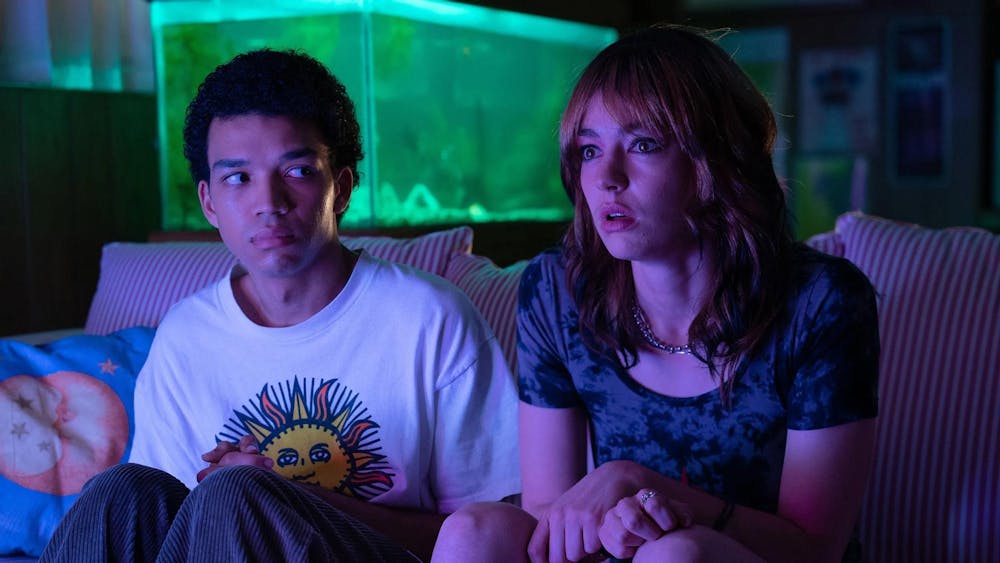Filled with low-budget CGI and costumes reminiscent of ‘90s TV shows, “I Saw the TV Glow” is a seemingly light-hearted movie that becomes increasingly unnerving as its characters grow up and are forced to face their own identities.
The film — directed by Jane Schoenbrun and scheduled to be released May 3 — was screened at the Granoff Martinos Auditorium this past Friday as part of the 2024 Ivy Film Festival.
The movie begins with an eerie shot of a suburban neighborhood before cutting to a young Owen (Ian Foreman) watching a TV show called “The Pink Opaque.” The scene then switches to a dimly lit school, where Owen meets Maddy (Brigette Lundy-Paine). A brief conversation between the two characters results in Maddy inviting Owen to her house to watch “The Pink Opaque,” a night that would transform both of their lives.
After a time skip of two years, an older Owen (Justice Smith) is seen binging recorded tapes of “The Pink Opaque” given to him by Maddy. One night, after reuniting in person to watch the show together, Maddy draws a pink ghost — a recurring symbol in the TV show — on the nape of Owen’s neck, causing him to see pixels and TV static above him.
The next morning, Owen attempts to scrub the pink ghost off his neck but is unable to remove it completely. From this point on, moments in Owen’s life become gradually more unsettling. After his mother passes away the next summer, Owen is further isolated by Maddy’s disappearance, as well as the simultaneous and sudden cancellation of “The Pink Opaque.”
Eight years later, Maddy returns, revealing to Owen that she has been inside “The Pink Opaque” and that Owen needs to free himself from the real world by burying himself alive. This ignites a never-ending process of questioning for Owen, who cannot seem to figure out whether his beloved childhood TV show was fictional or another reality.
One of the strongest points of “I Saw the TV Glow” is its use of light and color. Throughout the film, a sense of uneasiness is created by sets lit only by the glow of a TV. Meanwhile, color choices reinforce the film’s true purpose — a portrayal of the experiences of the transgender community, which is heavily alluded to by the disconnect that Owen feels between his body and the possibility of existing within “The Pink Opaque.” In the opening scene, Owen is illuminated by the pink lights from his TV, a possible allusion to the beginning of his journey of self-discovery and exploration of gender. Later, when Maddy and Owen are discussing their sexualities at school, attentive viewers may notice Maddy donning a blue top, while Owen wears a pink sweater.
Although the film excels in paying attention to technical detail, it forgoes a stronger connection with more casual viewers. The narrative chaos of the movie ultimately muddles its main message, leaving viewers confused as to how different aspects of the film fit into its overarching plot.
A grainy montage of flashbacks gives viewers a glimpse of a smiling Owen wearing a dress while spending time with Maddy. But this notable scene goes by too fast and appears far too late in the film, forcing viewers to rethink character details and continually reassess the plot.
Every aspect of “I Saw the TV Glow” — from the casting choices to the set design — contributes to the film’s overall message. But these details will probably go overlooked on a first watch, potentially requiring a second viewing for audiences to form a thorough understanding of their impact.
Although well-produced, “I Saw the TV Glow” feels more like a minefield of loose threads and vague subtleties than a cohesive narrative with a clear conclusion.
Manav is a junior from Indiana, concentrating in International and Public Affairs. In his free time, he likes attempting the daily Connections puzzle or falling down Wikipedia rabbit holes.





